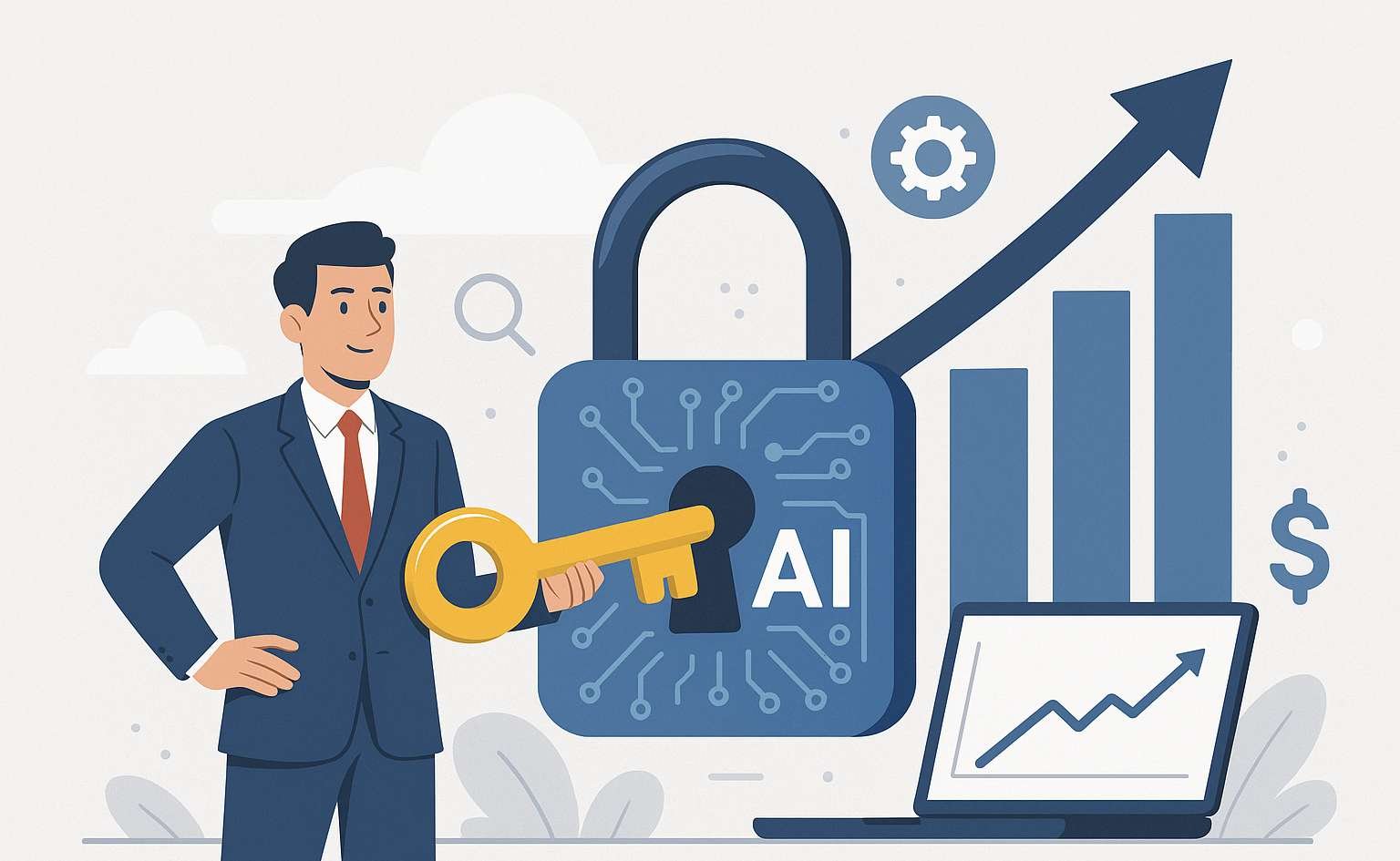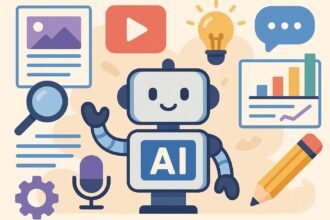Opening Insights into AI Integration
Strategically harnessing artificial intelligence in your business processes positions AI as a hidden advantage, unlocking untapped potential for maximized return on investment. Such optimization bolsters long-term financial health and lays the groundwork for scalable, sustainable business expansion. AI ingeniously extracts value and efficiency from existing data and infrastructure: machine learning algorithms analyze historical information to identify new opportunities, natural language processing systems deepen customer comprehension, and automation technologies streamline workflows and trim operating expenses. These capabilities empower enterprises to extend their footprint and fulfill unmet market demand with precision and speed.
For the uninitiated, artificial intelligence encompasses the intelligence demonstrated by machines. An overview of key concepts and structures clarifies the technical scope of AI and prepares executives and decision-makers for forthcoming discussions. Tracing the historical progress and milestones charted by artificial intelligence reveals insights into its expansive business applications. A review of current AI uses illustrates the pathways for—while case studies of successful implementation and lessons learned demonstrate the means of—maximizing financial return. Finally, an examination of the strategies driving long-term business growth underscores AI’s indispensable role in today’s corporate environment and confirms its place as a powerful differentiator in the marketplace.
Delving into the Realm of Artificial Intelligence
Artificial Intelligence (AI) serves as a powerful tool for maximizing return on investment and expanding business operations. AI encompasses systems that perceive their environment and take actions to achieve specified goals. These systems consist of intelligent agents capable of sensing, planning, reasoning, deciding, and acting to shape their surroundings. AI technologies fall into four broad categories: Machine Learning, Natural Language Processing, Computer Vision, and Robotic Process Automation. Within these categories, Machine Learning is pivotal for Business Applications such as marketing, advertising, lead qualification, and customer experience management.
At its core, AI involves enabling machines to learn, reason, plan, and act autonomously toward achieving objectives. Throughout business processes, companies generate vast volumes of structured and unstructured data, comprising valuable patterns and information. If effectively leveraged, this data can significantly enhance customer understanding, interaction, relationship management, and retention. Several AI Milestones—from the Turing Test and Deep Blue to Shakey the Robot and ALPHA GO—underscore the transformative journey of machine intelligence. The Business Application of AI spans manufacturing, banking, transportation, driving assistance systems, healthcare, and beyond.
Fundamental Concepts and Structures
Artificial intelligence (AI) broadly encompasses the capability of a machine to imitate intelligent human behavior. Greater specificity is often applied according to particular applications such as computer vision, driving cars, playing games like chess, and interpreting languages. These functionalities can be formally described in many distinct ways, including the ability to accomplish complex tasks, solve problems, cope with uncertainty or, conversely, to excel at difficult symbolic reasoning. More loosely, AI integrates any algorithm, method, technology, or technique that enables machines to imitate human cognitive features and behaviors such as planning, learning from experience, drawing logical conclusions, perceptual inference, driving cars, playing games, and interacting in natural language.
The underlying concept includes a multitude of definitions, structures, and taxonomies, partly depending on the particular types of features considered and the intended scope of the discipline. A few examples relate to categories of problems that can be addressed rather than the methods applied. Two main groups of applications are identified: (i) those that study how to replicate or simulate intelligence enabling to perform a set of particular tasks, and (ii) those devoted to increasing human intelligence through assistive technologies. A large category assumes that the human way of thinking and reasoning represent the best approach and focus on cognitive modeling, whereas other strategies might consider other aspects and try to mimic human behavior rather than cognition. Some approaches assume that human intelligence is the best or only way to tackle difficult tasks and focus exclusively on methods that mimic biological processes.
Types of AI Technologies
Artificial Intelligence (AI) may be defined as the branch of computer science concerned with the automation of intelligent behavior. By employment of dedicated systems or devices, certain functions of the human mind can be performed, including speech, vision, or moods. AI technologies may be categorized as interactive, analytical, and/or functional. Interactive technologies focus on interaction with human beings. Examples include chatbots responding to simple text questions, and virtual agents relating to customers in a human-like way. Analytical technologies understand, comprehend, or provide advice based on data. Analytical technologies do not necessarily have to mimic human intelligence. Examples include machine learning, complex data analytics, or business intelligence. Functional technologies allow the execution of specific tasks. Examples include robots performing specific actions, natural language generation, speech, and image recognition, fraud detection, or biometric identification. Recent developments promise to combine two or more categories of AI technologies to reach full potential.
Historical Progress and Key Milestones in AI Development
Development in the field of artificial intelligence (AI) began in the early 1950s. The term “artificial intelligence” was coined during the Dartmouth Summer Research Project on Artificial Intelligence in 1956. Early AI researchers were optimistic about the potential for building intelligent agents capable of solving complex problems, but progress was limited by the high cost of computing power. In the 1970s, the field experienced a so-called “AI winter,” during which funding and interest in AI research waned due to underwhelming results. The creation of expert systems in the 1980s, which incorporated domain-specific expert knowledge, helped revive interest. However, these systems were limited to narrow domains and struggled to address broader tasks.
Recent developments in machine learning, deep learning, and cognitive computing have enabled significant breakthroughs in AI. Deep learning models, which are multilayered neural networks inspired by the human brain, have been applied to image classification, object detection, and speech recognition. Reinforcement learning has shown success in robot navigation in cluttered environments, robotic manipulation, board-game playing, and self-driving cars. Notable achievements include IBM’s Deep Blue defeating chess champion Garry Kasparov in 1997; IBM Watson winning the Jeopardy! competition in 2011; and Google DeepMind’s AlphaGo defeating the top human player at Go in 2016.
AI in Business
Business organizations have applied AI, sometimes without calling it AI, for decades. Examples include the use of automated teller machines by financial services companies, as well as inventory control and electronic billing by manufacturers and retailers. Businesses have also deployed many tactical point tools that use AI technology, including sales forecasting, risk assessment, marketing decision support, and credit decision support. More recently, companies have begun to embrace AI technology as part of their strategic plan and corporate culture, particularly in the support of customers and research and development.
Recent advances in AI have expanded the field from purely academic or science fiction concerns into broadly commercial applications. The 1990s brought expert systems, neural networks, genetic algorithms, intelligent agents, fuzzy logic, and robotics out of research labs and onto desktops and factory floors. Innovation in the form of new algorithms, combined with the rapid maturation of supporting technology such as application-specific integrated circuits, virtual reality interfaces, and Internet gateways, is fueling increased growth in commercial applications of AI. Many companies are now automating complicated, time-consuming, and expensive business functions with the help of AI technology; these include business opportunity evaluation, data segmentation, market segmentation, cost reduction, customer relationship management, competitive positioning, and profit cycle analysis.
Current Applications of AI
Artificial Intelligence: Your Hidden Advantage for Maximizing Return on Investment and Business Expansion
In addition to its well-known role in achieving operational efficiency and facilitating business transformation, artificial intelligence also constitutes a hidden advantage by helping companies maximize return on investment. To illustrate, consider how AI can identify new markets, enhance customer experiences, and support strong, scalable growth.
Central to this capability are the tools and vendors that make AI a reality. Machine-learning platforms build systems that learn and improve based on data without explicit instructions. Natural-language processing (NLP) enables the comprehension of the structure and meaning of text. Robotic process automation (RPA) performs high-volume, repeatable tasks usually done by humans. Intelligent virtual agents chat and interact with humans in a natural language. A wide array of products can augment personal tasks or simulate human behavior, including tools for speech, text, and image recognition. These resources underpin companies’ ability to maximize return on investment and expand their operations.
Artificial Intelligence (AI) can be broadly defined as the imitation of intelligent human behavior. More specifically, it refers to computations that empower machines to control or emulate intelligent behavior, such as learning and problem-solving. This chapter—“Artificial Intelligence: Your Hidden Advantage for Maximizing Return on Investment and Business Expansion”—explores the current applications of AI.
Additional Insights
Fundamental Concepts and Structures
Four-dimensional mapping identifies key concepts and the temporal patterns that connect them, guiding the exploration of Rich-Content Mappings, Models, and Views. A Study of Types categorizes AI theories and technologies into domains. Milestones in Development highlight significant achievements that have advanced the field.
Case Studies of Successful Implementation
Whether AI implementation is the integration of a tailored chatbot that reduces customer support costs or the deployment of AI-powered sensors that enhance product quality and reduce manufacturing costs, AI is changing businesses for the better. AI products are also constantly being expanded to protect customer identity and data, as well as reduce the risk of cyberattacks.
Amazon was one of the first to build a holistic technology stack, implementing machine learning across a variety of different business units and processes through processes, people, and technology. Sears Holding Corporation launched smart price tags powered by AI that can automatically manage the pricing of displayed products, significantly reducing the need for people to set the prices through a centralized dynamic pricing platform. In business scenarios such as business process optimization, logistics and supply chain services, evocative feedback, customer churn prediction, operational risk, and financial data-based products and services, ICICI has implemented AI-driven solutions that can generate value at scale.
Challenges and Limitations
Artificial intelligence enables businesses to achieve maximum return on investment and scale expansion by being a force multiplier for human efforts and enabling them to do more with less. A force multiplier enhances results by increasing efficiency and productivity. Through AI, businesses can accomplish more while simultaneously reducing costs and optimizing current investments, leading to a significant increase in return on investment.
The challenge lies in the fact that many AI offerings are labeled mere “business applications,” rendering AI as a buzzword to some, yet sending fear and confusion to others who have not embraced the technology. When implemented appropriately for the right purposes, AI can dramatically enhance a business’s performance. Conversely, inappropriate use can lead to increased costs and project failures.
Maximizing Return on Investment
Artificial intelligence technologies can be a hidden advantage in maximizing return on investment. AI systems make decisions and predictions based on data, adapting to new information with limited human intervention. Eliminating repetitive or difficult tasks saves money, frees employees for higher-level work, and cuts error-related costs. Addressing small areas of inefficiency sums to big savings. Leveraging Big Data with AI can identify new markets and increase customer lifetime value, fueling business growth and delivering a powerful, long-lasting return.
The cost-benefit analysis of artificial intelligence is favorable for most organizations. Project expenses include additional infrastructure, skilled personnel, data storage and processing, and model training. Benefits flow from reduced operational expenses, enhanced decision-making leading to increased revenue, and minimized risks. As complex AI models evolve, business users can harness their power through smarter platforms that require less technical expertise, making a substantial return on investment achievable across diverse business scenarios. The right AI tools and techniques enable expansion into new markets, improved customer experience, and scalable operations that strengthen growth strategies.
Cost-Benefit Analysis of AI Integration
The challenges and limitations inherent in AI-based solutions—ranging from data insufficiency to implementation biases—serve as hurdles that can impede business decisions. Nevertheless, a comprehensive examination of the financial implications is necessary to determine the viability of AI adoption within an organization. Such a cost-benefit analysis elucidates both the advantages and potential pitfalls, thereby facilitating strategic planning.
A return on investment (ROI) analysis offers a quantifiable perspective on AI’s value proposition. Although many companies focus on short-term financial gains, AI should be assessed on its capacity to generate long-term competitive advantages—such as rapid product iteration and enhanced customer engagement. The initial costs of AI deployment—including infrastructure setup, employee training, and model fine-tuning—may appear prohibitive. However, organizations that recognize AI as akin to a core business system rather than merely a decorative enhancement are more likely to secure the necessary resources. Even smaller enterprises can derive benefits; the proliferation of accessible AI products and tools has lowered entry barriers, creating a thriving market for AI-driven solutions.
Measuring ROI in AI Projects
An increasing number of enterprises are exploring artificial intelligence (AI) for numerous business applications. Application scenarios, benefits, and industry perspectives can be assessed with the assistance of artificial intelligence when it is properly matched to a given industry and business demand. Success stories for business applications along with listings of other benefits related to business applications are continuously being made public. Tighter technologies, including big data, are gradually being integrated. With the support of these technologies, artificial intelligence is moving closer to mainstream applications and is becoming part of daily lives.
The analysis and estimation of return on investment (ROI) from AI-based company offerings have, nevertheless, not received as much attention, despite the fact that it is one of the most important elements for the financial success of the whole organization. Without an established plan, potential investors may be hesitant to invest in AI technology. Simple initiatives might seriously undermine company trust or increase costs without a clear objective. Businesses must account for these aspects when evaluating and employing AI technology in order to maximize their ROI on AI investments. Upfront cost is a consideration and major impediment for numerous companies thinking about incorporating AI capabilities. Before introducing AI functionality, an appropriate cost–benefit analysis must be done.
Long-term Financial Benefits
A cost-benefit analysis of artificial intelligence (AI) integration shows the direct and indirect ways a business benefits from incorporating AI-powered tools and technology into its infrastructure. Analysts assess the actual costs of initial AI implementation and ongoing maintenance against the real financial gains. This comparison reveals whether an AI platform provides an adequate return on investment. In many applications across industries, enterprises have discovered substantial long-term financial benefits. With careful implementation, AI can prove a hidden advantage by maximizing business return on investment and facilitating scalable growth.
The long-term benefits of using AI to maximize return on investment depends on viewing the ratio between net gains and implementation costs within a broader financial context. Analysts study companies reporting success after implementing one or more artificial intelligence platforms. Their analyses include specific, experienced, and observable business applications. Cost‑benefit analyses show where direct and indirect financial gains exceed direct and indirect costs. Direct costs cover hardware, software, staff training and onboarding, ongoing monitoring and maintenance, and any costs created by product issues. Direct financial gains come from tasks that AI can perform less expensively or more efficiently than people. Indirect costs represent damages to brand name, reputation, and customer or supplier relationships. Indirect earnings consist of enhancements to brand value and reputation, competitive positions, and business image—in fact, everything that contributes to a stronger, healthier, and more competitive company. The picture that emerges suggests when AI is first integrated, it almost always creates financial stresses as costs increase and realized benefits are relatively minor. But savvy enterprises view these financial stresses as a natural, albeit challenging, aspect of AI adoption. They know that, as people become more skilled in using artificial intelligence, the potential to increase revenues and profitability embody AI’s real hidden advantage.
Business Expansion Strategies
Once businesses have built the foundation for profitability and maximized their return on investment, the next logical step is operation expansion. Artificial intelligence services can identify business niches and growth opportunities by analyzing customer preferences and identifying unmet needs, facilitating targeted marketing and tailored product development. AI-driven chatbots and virtual assistants enhance customer experience and satisfaction by offering assistance around the clock, thereby improving loyalty and boosting revenues. Similarly, AI-enabled automation facilitates business expansion by streamlining operational processes—such as hiring, accounting, and inventory management—enabling seamless scaling while reducing costs and errors.
Several AI technologies contribute to business expansion and return-on-investment maximization. Machine-learning platforms predict consumer behavior and tailor marketing campaigns to increase customer engagement and sales. Natural-language processing applications assess customer sentiments and reviews, informing promotional strategies and product refinement. Intelligent automation systems oversee repetitive tasks, freeing resources for growth initiatives and enhancing operational efficiency.
Identifying Market Opportunities
According to the McKinsey Global Institute, between 2017 and 2019, the applications of AI and analytical techniques across all industries averaged $0.5 trillion in value added annually, constituting approximately 22% of the total value added by Information and Communication Technology (ICT) globally. These applications also provided an estimated 25% boost in labor productivity globally during that period. AI has demonstrably surpassed the stage of being a hype-driven, futuristic technology. Today, it stands as an essential ingredient for driving smart business expansion, benefiting customers, and maximizing return on investment.
Maximizing ROI constitutes a primary incentive for AI implementation. Businesses that successfully deploy AI tend to lower operational costs, enhance production efficiency, and, consequently, improve profit margins. At the same time, AI enables companies to utilize the substantial savings generated to sustainably expand business operations across untapped markets. Another important aspect of business expansion involves customer engagement. Modern customers expect companies to engage with them exactly where and when they want, assure high service quality and provide their brand experience across all touchpoints.
Enhancing Customer Experience with AI
Providing excellent customer service and support is essential for keeping new and existing customers happy and loyal. With AI, a business can better anticipate customer needs and provide the right support at the right time — even before a customer asks for help. An AI-powered customer experience solution can automate a wide range of service-related tasks and transactions, freeing up employees to focus on things like retention and upselling. It can also be connected to marketing to help optimize the customer journey and boost revenue.
When AI is set up to recognize buying signals and other “moments of truth,” it can start complex customer journeys to help increase conversions or boost satisfaction. For example: when a customer submits a support ticket, AI can recognize their frustration and route the case to an empathetic employee, or send the customer to a self-help knowledge base with instructions. In retail, consumers can send images of damaged items directly to a company chatbot for hassle-free returns. Online, AI provides support beyond chat, responding with rules and suggestions based on shopper wants and needs. Thanks to its ability to generate new conversation templates and types on demand, it can engage shoppers everywhere — on social media, in email, and over the phone. If a shopper is browsing products or visiting the same webpage repeatedly, it can send tailored, personalized messages to boost conversions and sales. Overall, these expanded AI employee capabilities result in a more well-rounded customer experience, generating increased sales.
Scaling Operations Using AI
What if one can expand beyond that? What about moving into different geographic areas? What about scaling your company to a much larger size? Let’s examine how the use of artificial intelligence can help with those expansions.
A company that wishes to expand its operations will have the following goals. First, the company wants to increase the number of customers it serves. Second, the company wants to increase the number of products it sells. Third, the company wants to increase the number of employees on staff. Human resources can be used to serve customers, manufacture products, and keep the company running. In addition to these goals, the company should contemplate the following question: “What part of the company’s operations are highly manual, repetitive processes that could benefit from a machine-learning or natural-language-processing solution?” By answering this question, the company will add greater scalability to its operations.
Technologies for expanding a company’s operations include machine learning, natural language processing, and automation. The application of these technologies results in cutting costs, generating new revenue, identifying potential markets, improving the customer experience, creating new processes or products, and building a scalable operation.
AI Tools and Technologies
Artificial Intelligence platforms are transforming every aspect of business management and growth, with costs very likely to be recouped many times over through improved operational efficiency, market research, risk management, and financial decision-making. Key tools and technologies include machine learning, natural language processing, and automation. These versatile solutions reduce human bias, optimize workflows, and open hitherto unimagined expansion opportunities.
Machine learning encompasses adaptive algorithms and enabling frameworks that assess an organization’s current status and make recommendations to improve and automate business functions. Natural language processing (NLP) enables computers to grasp, analyze, and infer the underlying meaning behind customer communications, market feedback, and publicly available data. Automation is the creation of software agents that perform repetitive and mundane tasks, freeing valuable employee focus for higher-value work.
Machine Learning Platforms
Machine learning platforms aren’t new, but they have greatly expanded with the rise of artificial intelligence technology. Machine learning platforms provide the tools businesses need to build, deploy, and manage machine learning models by offering the algorithms, APIs, automation, data processing, and preparation functions that reduce tedious and time-intensive tasks. One advantage of these platforms is their ability to improve machine learning bidirectionally through supervised and reinforcement learning. Supervised learning means the model is presented with training data that has known labels, allowing it to adjust until it gets the correct answer. Reinforcement learning models learn through trial and error by receiving rewards for desired outcomes. Since obtaining large datasets with accurate labels can be prohibitively expensive for businesses, reinforcement learning presents a strong alternative. However, reinforcement learning typically requires more time for a model to determine the optimal approach. These diverse approaches enable businesses to shape machine learning output based on cost structure and time constraints.
Natural language processing (NLP) models are complex, expensive to build, and require vast real-world data for training and testing. Recent breakthroughs in language modeling have led to quality NLP output with substantially fewer data. The GPT (generative pretrained transformer) architecture offers a powerful template upon which organizations can build models tuned to specific business scenarios, products, services, and use cases. Matching the right NLP tools with business needs enables stakeholders to provide meaningful, real-time responses to customers at critical points in the customer journey.
Natural Language Processing Tools
Natural Language Processing tools bring speed, agility, accuracy, and operational flexibility to respond to customer needs at scale. Advanced NLP platforms provide rapid information retrieval along with detailed spoken responses—all without the help of another person. As a result, they deliver a seamless experience for customer and company alike. These tools are especially adept at answering questions that are difficult, complex, or financially sensitive such as credit card interest rates, interest rates on mortgages, or details of risk insurance packages.
At an operational level, NLP tools deliver quick, flexible, and on-demand answers to complex questions without requiring additional human resources. These solutions reimagine what self-service means in the contact center and workplace; they reduce reliance on reinforcing existing call deflection and automation initiatives and instead create intelligent, scalable solutions for supporting customers as well as employees.
Automation Solutions
Automation solutions refer to a broad set of techniques or systems that use machines and computers rather than humans to do work. While automation computing and machinery cannot replace human beings, it helps people perform repetitive or tedious work more effectively. Automation tools are widely used in industry, business, and daily life, and contribute to controlling costs, improving quality, and enhancing customer satisfaction.
Rapid developments in high-performance processors and vast data resources have made automation tools more affordable and practical. Tools for automated recognition are based on Machine Learning (ML) techniques, including Plant Recognition, Image Recognition, Speech Recognition, and Face Recognition; tools for Automated Text, based on Natural Language Processing (NLP) techniques, include Sentiment Analysis, Language Translation, and Text Generation; while Automation IT tools, based on AI technology, serve software developers during the software testing process.
Ethical Considerations in AI
Ethical considerations constitute a fundamental part of effective, responsible AI deployment, particularly when sensitive customer data is involved. Data privacy remains an area of growing concern and discussion. Organizations must carefully review their use of data, obtain informed customer consent, and take all appropriate steps to mask or protect personally identifiable information.
Similarly, bias and fairness in AI are ongoing issues that require active attention. The training data employed for AI systems must be diverse and inclusive enough to mitigate the risk of inadvertent bias—for instance, not only addressing known instances of bias, but also recognizing that not all forms are apparent or quantifiable. Enterprise users should monitor AI performance regularly to detect hidden bias and ensure back-end retraining accomplishes its intended purpose.
Regulatory compliance also has a role in ethical AI use and deployment. Organizations need to consider general national and regional requirements—such as the EU’s General Data Protection Regulation and Cybersecurity Act—as well as industry-specific rules. Moreover, a growing number of countries have introduced AI-specific regulations or providing guidance proposals, which organizations must track and implement as necessary to uphold ethical principles.
Data Privacy and Security
Data privacy and security represent critical issues for organizations deploying AI tools. The world grows more connected each day, with vast troves of information exchanged across online platforms and wireless networks. As a result, organizations are acquiring unprecedented amounts of customer data. Sophisticated monitoring technologies can track individuals’ online behavior. Recent events such as site data breaches, viruses, and other attacks have displayed how vulnerable the Internet and its users are to hackers and those with malicious intent. As AI applications move into the public domain, organizations are collecting, storing, and processing more data, often containing confidential customer information, to generate AI-based solutions. If a data breach occurs, confidential information may fall into the wrong hands. Vulnerable data could be exploited by terrorists for their own evil desires, which could lead to damage or harm. For this reason, organizations must give the utmost priority to data privacy and security.
There is a wide consensus that poor decisions and accidents during AI design can have serious social, legal, and economic consequences. Regulators are becoming increasingly concerned about the technological redressability of AI-related accidents. At the same time, regulators have shown a narrowing of space for exemptions from the general duty to provide a remedy in such accidents. On the other hand, the growing public reliance on AI suggests that unconvincing decisions could be extremely difficult to handle. The challenge is to ensure that AI systems are designed in ways that prevent or minimize Lego block-related accidents without postponing the arrival of beneficial innovations and too intensely blocking the evolution of AI-based applications.
Bias and Fairness in AI Systems
Artificial intelligence systems do not exhibit a human understanding of the world. Given the data and a learning objective, machine learning algorithms uncover statistical relationships that approximate the underlying functions useful for making decisions. Because the data used to train AI systems captures existing aspects of our culture, institutions, and people, they are susceptible toRAS–bias, and consequentially create disparate impact on protected groups. These considerations have become imperative to address in AI systems, as the deployment of AI filters, neural nets, and other algorithmic decision-making frameworks have taken hold in sensitive decisions about the future of people.
When ethical considerations, accountability, and transparency are inadequately addressed in the design, development, and deployment of AI systems, problems can arise. These systems can generate biased outcomes and potentially cause harm by perpetuating existing biases or discrimination present in the training data or learned through their functions. The ethics of fairness, representativeness, inclusivity, and the mitigation of bias in AI system development has become an emerging area of AI research and development. There are potential explanations for the sources of bias, as well as methodologies for the detection, mitigation, and evaluation of bias and fairness in machine learning models.
Regulatory Compliance
Compliance is a major challenge when it comes to AI implementation. The ever-evolving and extensive compliance landscape requires thorough policy management, configuration, and enforcement. As regulations continue to expand, organizations need to adapt swiftly to avoid non-compliance penalties and maintain trust with customers, business partners, and regulators.
Implementing standardized structures and policy guardrails automates compliance workflows across every user environment. This approach enables organizations to support an increasing number of users—whether employees, developers, operations personnel, or stakeholders—while managing the multi-cloud journey. The goal is to prevent shadow IT scenarios that result in silos, bottlenecks, and governance blind spots. Comprehensive, ongoing enforcement ensures secure adoption of cloud services, allowing users to remain productive and align with organizational compliance requirements.
Future Trends in AI and Business
Industrial revolutions have reshaped the world more than once. First, the advent of the steam engine propelled society into the machine age. Then the arrival of the electricity grid paved the way for mass production. Finally, the introduction of the transistor jump-started the information age. Now, with the development of digital computing, organisms can perform inhumanly large calculations.
Artificial intelligence is a significant technological advance. More data are created today than ever. Companies from many industries—software, financial services, healthcare, and others—are acquiring new knowledge from data faster, with more accuracy, and at less cost using algorithms. Artificial intelligence is on the verge of triggering a paradigm shift that unlocks previously unexplored human potential and leads to a sustainable future for all. It has immense demand in every sector, from mundane everyday activities to the defense and household. The cricket fan is enthralled by the information displayed on the screens during matches, while the watchful driver is aided by the Smart Brake Assist system. The driverless vehicle is no longer a distant daydream of movie buffs; it is fast becoming a reality. Artificial Intelligence (A.I.) and robotics have taken over tedious and hazardous jobs in the manufacturing sector, allowing people to concentrate on other, more important tasks.
Emerging Technologies
Numerous emerging technologies hold a transformative potential for the future. A recently published article identifies twelve such trends and associated technologies. The initial identified technology is artificial intelligence (AI), whose extensive engagement and application can surpass human capabilities in both the digital and physical realms. Furthermore, the following trend focuses on the symmetrical enhancement or reduction of the scale and size of operational activities. Maximizing return on investment while simultaneously expanding businesses can be regarded as the two sides of a coin—symmetrical opposites. Using artificial intelligence (AI) as a hidden advantage can facilitate optimal business growth.
Artificial intelligence (AI) can be broadly defined as the capability of a computer system to mimic or replicate intelligent human behavior. As a hidden advantage, employing AI enables the attainment of maximum possible return on investment for stakeholders.
Predictions for AI in Business
Advanced AI 2.0 will transform the way investment companies communicate, a real challenge for executives and business leaders who anticipate private company sponsors leveraging AI technology.
Nearly every industry vertical is exploring AI, ranging from automotive engines and finance to triple-A (AAA) video games, where the enemy is controlled by AI. Text generation applications are already here, and that domain represents an entirely new category of AI-related services. This continued rapid advancement may eventually eliminate language as a barrier to business and cultural exchange. Removing language as a major barrier to doing business will ultimately help advance education and a sustainable lifestyle for all, since businesses within every sector can focus on bringing value to their customers.
The Role of AI in Sustainable Development
Artificial Intelligence (AI) also plays a significant role in achieving the United Nation’s Sustainable Development Goals (SDGs). AI models, especially the Foundation Models, perform well in several applications, including smart cities, healthcare, agritech, transportation, infrastructure management, and green energy. Artificial Intelligence enables efficiency across the board, regardless of the specific goal, providing the critical intellectual infrastructure for an inclusive society that is built to last. Organizations, governments, universities, and development agencies are harnessing AI’s potential to innovate novel ways to tackle some of the world’s toughest challenges.
Progress in different social sectors is not only good for humanity; it also translates into smoother, more productive business. Artificial intelligence is simultaneously a complement to the SDGs—accelerating progress towards their achievement—and an enabler of inclusive, thriving economies. Lisa-Maria Neudert, a senior research fellow at the University of Oxford’s Internet Institute who studies AI policy, argues, “The Future is not an AI story: AI only has an auxiliary role in enabling the SDGs and complementing human capabilities towards a better future.”
Conclusion
Artificial Intelligence: Your Hidden Advantage for Maximizing Return on Investment and Business Expansion Artificial Intelligence can be your hidden advantage for maximizing ROI and scaling your business. The potential of AI extends far beyond cost reduction. Artificial Intelligence (AI) is a branch of computer science that aims to create intelligent machines capable of performing tasks that require human intelligence. Indeed, AI transforms data into meaningful information, enabling computer programs to grow smarter over time and equipping businesses with the intelligence to adapt and excel. When understood and applied appropriately, AI provides businesses with the intelligence required to scale and succeed.
Integrating AI into your strategic planning process enables your company to continually visualize and deliver new benefits for your business. Every business seeks hidden advantages influencing customers—whether through correlations found in data or forward-looking insights indicating where customers want to go. Unfortunately, the notion of “hidden advantage” typically remains an abstract aspiration. However, AI presents a compelling strategic avenue for companies aiming to outpace competitors in the quest for hidden advantage. The critical questions are: How can a business maximize its return on investment by integrating AI? And how might AI empower expansion into new regions or the enhancement of customer experiences?












